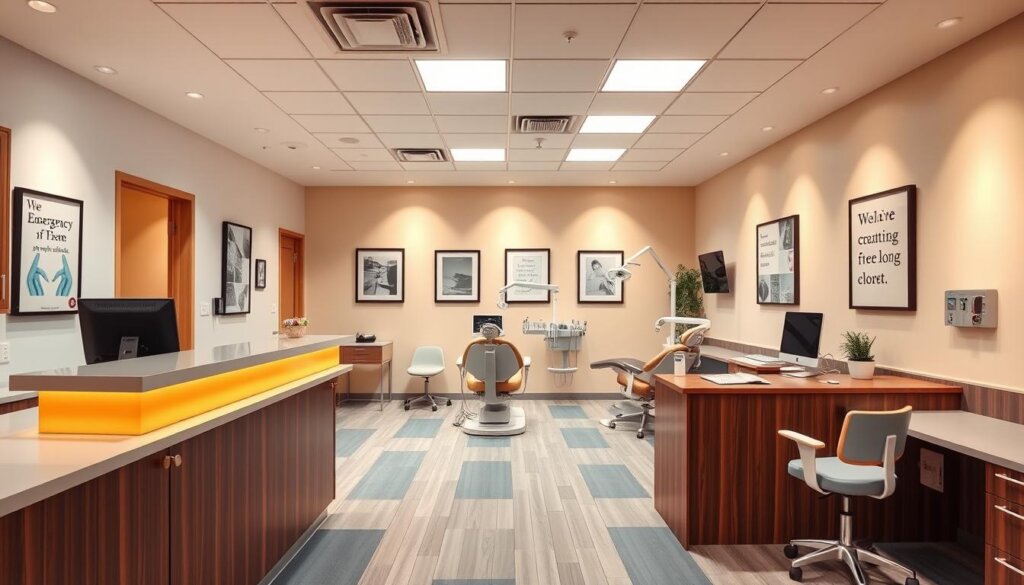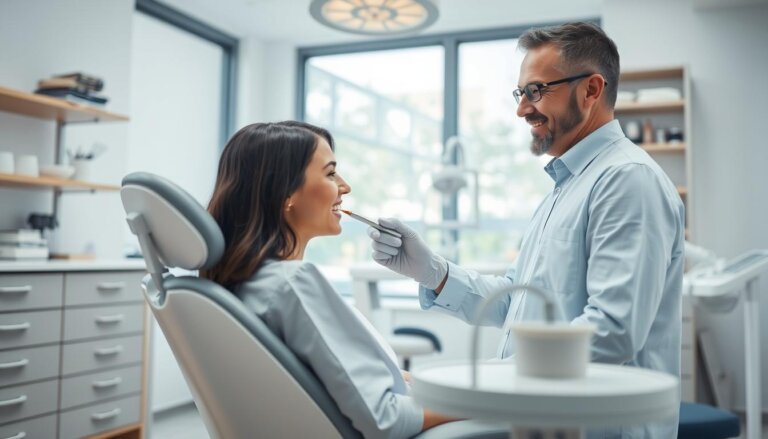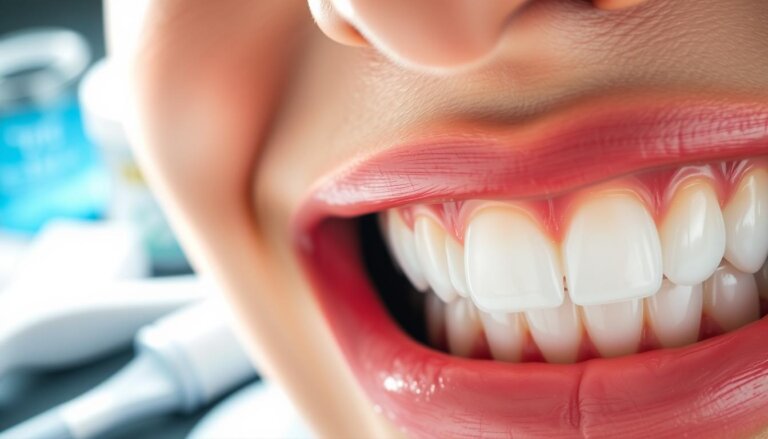Immediate Care for a Broken Tooth – What If?
Every year, over five million dental injuries occur in the United States. This leaves many people unsure of what to do next. A broken tooth can cause a lot of pain and might even lead to infection if not treated right away.
Experts say rinsing your mouth and stopping any bleeding are the first steps to take. Getting urgent dental care can prevent more serious problems that could harm your oral health. This initial action is key to keeping you safe until you can see a dentist.
Key Takeaways
- Broken teeth can trigger rapid infection if left untreated
- Rinsing the mouth and stopping bleeding help preempt complications
- Prompt dental care remains vital for preventing deeper fractures
- A broken tooth may involve sharp edges that irritate soft tissues
- Consulting professional help soon after injury ensures better outcomes
Understanding a Broken Tooth
Any damaged dental structure can disrupt daily life and affect overall oral well-being. Accidents during sports, biting down on dense objects, or undue stress from nighttime grinding may weaken enamel. Recognizing key influences on fractures helps professionals and patients take preventive measures that encourage lasting oral health.
Common Causes of Tooth Breakage
Excessive force often comes from collisions, falls, or grinding habits. Dental enamel endures considerable pressure when individuals bite hard candies or unpopped popcorn kernels. Repetitive clenching wears down protective layers, making cracks more likely.
Symptoms of a Broken Tooth
Localized discomfort, sensitivity to hot or cold liquids, and rough edges are frequent indicators of structural trauma. Irritation along the cheek or tongue may occur if fractured surfaces become jagged. Swelling in nearby gum tissue can signal deeper disruption within the underlying oral anatomy.
Importance of Prompt Treatment
Seeking timely evaluation reduces the chance of infection penetrating the compromised area. Early clinical intervention may lessen the need for extensive restorative procedures or root complications. Proper diagnostics promote tailored solutions that preserve natural function and enhance long-term health for all patients. This approach fosters better outcomes for both comfort and aesthetics. It aims to protect vital structures from irreversible harm.
Assessing the Damage
Dental experts check visually and ask patients about their pain to see how bad a break is. A small chip might look okay, but it can be serious if it goes deep into the tooth. Catching it early helps avoid infection and keeps the tooth healthy.
Types of Tooth Breaks
Doctors sort breaks into types based on how deep they are and what part of the tooth they hit. They look at:
- Surface cracks limited to enamel
- Fractures exposing dentin and risking sensitivity
- Vertical splits affecting the root
Identifying Severity of the Break
X-rays and how the patient feels show if the nerve is in danger or if the root is hurt. If there’s swelling, an endodontist might need to step in. Quick action can stop pain and infection from getting worse.
First Aid for a Broken Tooth
Acting fast when a tooth breaks can prevent bigger problems. Mild swelling and tenderness often show up quickly. Taking early steps can help cushion the impact.
Dentists recommend simple steps to help until you can get to a dentist. These steps remove debris, ease pain, and prevent more damage.
Rinsing with Salt Water
A warm salt water rinse helps clean the broken tooth and fights bacteria. The American Dental Association says to mix half a teaspoon of salt in eight ounces of water. This creates a gentle antibacterial solution. Swish for 30 seconds to soothe the gums and reduce swelling.
Using a Cold Compress
A cold compress can help by reducing swelling. Use ice or a chilled gel pack. Apply it to the outside of your cheek for ten minutes, with gentle pressure.
Pain Management Options
Over-the-counter pain relievers like ibuprofen or acetaminophen can help with pain. A pharmacist can guide you on the right dosage. If pain persists or worsens, see a dentist right away.
Temporary Solutions Until You See a Dentist
When you have a broken tooth, you need ways to ease pain and protect your tooth. There are quick fixes you can do at home to help. But, seeing a dentist is the best solution.
Using items made for tooth protection is a good start. They can stop sharp edges from hurting your mouth’s soft parts.
Dental Wax for Protection
Dental wax can cover up rough spots on your tooth. It helps protect your gums and cheeks. You can find this wax at most pharmacies for small tooth cracks.
Over-the-Counter Pain Relief
Medicines from clinics or stores can help with pain. They won’t mess up your dental plans. Always follow the dosage on the label for safety.
Foods to Avoid
Stay away from hard, chewy, or sticky foods. They can make your tooth pain worse. Eating soft or liquid foods can give you some relief. Choose foods that are easy to chew until you see a dentist.
When to Seek Immediate Care
People with a broken tooth might not rush to urgent care. Waiting too long can cause bigger problems. If you’re bleeding for more than 15 minutes or in severe pain, it’s a dental emergency.
- Bleeding that fails to subside with clean gauze
- Sharp, throbbing pain that disrupts normal activities
- Visible nerve exposure or increasing swelling around the affected area
Signs of a Dental Emergency
Constant pain often means deeper damage. Uncontrolled pain and redness might mean infection. Swelling and fever are serious signs.
Seeing a dentist early helps protect your gums and speeds up healing.
Differentiating Between Urgent and Non-Urgent Cases
Small chips or minor cracks might not need immediate care if there’s no bleeding or infection. But, if you have big damage, exposed nerves, or swelling, you need to see a dentist fast. Quick action can prevent abscesses or bone problems.
“Prompt attention can prevent serious complications and ensure the best possible outcome.” — American Dental Association
Emergency Dental Services
Unexpected tooth damage can happen at any time. Quick action is key to avoid bigger problems. Local clinics work with hospital teams to provide urgent care for serious issues.
Finding an Emergency Dentist Near You
Online directories can help find emergency dentists. They show ratings and availability. Phone calls can confirm if you need immediate care.
They might find clinics ready for emergencies like knocked-out teeth or bleeding.
Understanding After-Hours Services
Dentists available late or on weekends handle urgent cases. They deal with broken fillings or severe pain. Their goal is to provide quick relief with modern tools.
Cost Considerations for Emergency Care
Costs vary with the procedure’s complexity. Some dentists offer payment plans or accept many insurances. Talking about costs upfront helps make better choices.
| Procedure | Estimated Range | Insurance Tip |
|---|---|---|
| Urgent Exam | $100 – $250 | Contact provider to confirm coverage |
| Tooth Stabilization | $200 – $500 | Partial coverage likely |
| Complex Fracture Repair | $300 – $900 | Pre-approval may lower out-of-pocket cost |
Improvising with Home Remedies
When a tooth breaks, some people look for quick fixes at home. Simple methods can help with pain and protect sensitive areas. But, it’s important to see a dentist soon to avoid bigger problems.
Natural Pain Relievers
Clove oil has eugenol, which can ease tooth pain. A few drops near the tooth can help. Saltwater rinses also clean the mouth and may reduce swelling.
Temporary Dental Fixes
Store-bought dental cement or wax can cover the tooth. This stops irritants from reaching the nerve. It’s a quick fix until you can get to a dentist.
Keeping Your Mouth Clean
Protecting a damaged tooth starts with a clean mouth. Germs can cause inflammation and slow healing. Good habits help keep exposed tissues safe.
Importance of Oral Hygiene
Good daily care fights off harmful bacteria around a broken tooth. The American Dental Association suggests gentle methods to avoid pain. Simple steps help prevent infection and aid in healing.
Recommended Oral Care for a Broken Tooth
These steps help keep your mouth clean without hurting the damaged tooth:
- Use warm saltwater rinses to cut down on bacteria.
- Choose a soft-bristled toothbrush to avoid hurting weak spots.
- Avoid strong mouthwash that might sting exposed nerves.
Regular hygiene shows you’re actively helping your tooth heal. Careful cleaning and quick dental visits are key to successful treatment.
Preventive Measures for the Future
Regular habits help keep teeth strong and avoid urgent dental visits. Simple actions like brushing and using mouthguards play a big role in oral health.
Maintaining Strong Teeth
Eating foods rich in calcium and vitamin D helps teeth stay dense. Fruits and veggies are full of nutrients that protect teeth. Drinking water also helps by cleaning the mouth and boosting saliva, which fights off bacteria.
Regular Dental Check-Ups
Regular dental visits can spot problems early. Dentists use advanced tools to find cracks, plaque, or decay. This can prevent pain and save time in the long run.
Protective Gear for Sports
Playing sports with physical contact increases the risk of dental injury. Custom mouthguards protect teeth during these activities. Groups like the American Academy of Pediatric Dentistry recommend them for their comfort and effectiveness.
| Strategy | Benefit |
|---|---|
| Calcium-Rich Foods | Strengthen enamel and prevent bone loss |
| Dental Cleanings | Remove hidden tartar and reduce gum problems |
| Custom Mouthguards | Protect teeth from impact during sports |
The Role of Dental Insurance
Having dental insurance can help avoid big bills when you need urgent dental care. It might cover things like fillings or more complex treatments. But, each policy has its own rules. It’s important to know what your plan covers.
This includes things like deductibles, waiting times, and how much you’ll have to pay out of pocket. Knowing these details can help you plan better.
Understanding Your Coverage
People usually check their policy documents to see what’s covered. Looking at the list of network providers can also save you money. Each plan has its own rules for things like crowns, root canals, or emergency care.
It’s a good idea to keep track of any pre-existing conditions or how much you can use each year. This way, you won’t be surprised by unexpected costs.
- Confirm plan details through official websites
- Ask about any pre-authorization steps
- Gather documentation for claim submissions
What to Do If Uninsured
Not having insurance shouldn’t stop you from getting help for a broken tooth or pain. Look into public health centers or charities that help based on income. Some places offer payment plans that might work for you.
- Investigate sliding-scale fees at community clinics
- Contact local dental schools for reduced rates
- Seek short-term financing plans
| Option | Description |
|---|---|
| Employer-Sponsored Plans | Often higher coverage but limited provider network |
| Private Insurance | Flexible choices, varies in price and copayment rates |
| Sliding-Scale Clinics | Reduced fees for uninsured or low-income patients |
Looking for Non-Traditional Care
Digital platforms have changed how we deal with urgent dental issues. They offer expert advice through online services. This reduces wait times and gives a first look at the problem.
Consulting with Dental Apps
Many people use apps to connect with licensed dentists. These apps have chat or video call features for quick help. Users can share photos, describe their pain, and get advice on what to do next.
- Secure communication channels with dentists.
- Easy appointment scheduling for follow-up visits.
- Reminders for important aftercare steps.
Online Dental Consultations
Telehealth solutions let patients talk to remote specialists. They can assess the tooth’s damage and even prescribe medication. This can speed up getting the care you need before seeing a dentist in person.
| Method | Potential Benefit |
|---|---|
| Dental Apps | Instant guidance without travel |
| Online Consultations | Faster prescription options |
Recognizing Complications from Ignoring a Broken Tooth
Ignoring a broken tooth can lead to serious problems. Bacteria can get into the tooth, causing pain and damage. This can harm the tooth and other parts of your mouth.
Potential Infections
Even a small crack can be a big problem. Bacteria can quickly get inside. This can lead to:
- Abscess Formation in soft tissues
- Severe gum inflammation and swelling
- Heightened pain from infected nerve endings
Impact on Adjacent Teeth
Ignoring a broken tooth can harm others too. The damage can spread to nearby teeth. This can make eating and talking painful.
| Complication | Possible Outcome |
|---|---|
| Deep Infection | Intense pain and possible systemic spread |
| Bone Degeneration | Greater risk of tooth loss over time |
Managing Anxiety and Stress
When you need urgent dental care, you might feel really worried. Talking to a dentist you trust can help. Mindful breathing can also calm you down. Knowing what will happen can make you feel more in control.
Tips for Dental Anxiety
Try guided relaxation to keep your breathing steady. A short break before your treatment can help you focus. Visualizing happy memories or images can distract you from pain.
Talking about your fears can also make you feel less anxious.
Strategies to Calm Nerves
Some people find sedation dentistry helpful, like nitrous oxide. It can make you feel less stressed. Counseling or therapy can also offer extra support.
When dentists are open and clear, it makes you feel more at ease. This creates a calm space for everyone worried about dental visits.
The Recovery Process After Treatment
After fixing a damaged tooth, you need to take simple but important steps every day. Gentle care helps the healing process. It also keeps you from facing unexpected problems.
Follow-Up Care Guidelines
Use a soft brush and rinse with mild saltwater to soothe sensitive spots. Your daily routine should include:
- Gentle flossing around the repaired area
- Following any medication or antibiotics your dentist prescribes
- Watching for any ongoing pain or discomfort
These actions help keep your mouth clean and safe from harmful bacteria.
Signs of Complications After Treatment
Look out for signs like swelling, pain that won’t go away, or discharge. If you notice these, see your dentist right away. They can stop infections or damage before it gets worse. Be on the lookout for:
- Throbbing pain that gets worse at night
- Swollen gums near the treated tooth
- Blood or pus at the repair site
Being alert to changes helps keep your mouth healthy and supports a smooth recovery.
Resources for Further Help
An unexpected broken tooth can feel overwhelming. Yet, many dental organizations and public health programs are always ready to help. They provide urgent care details and advice on infection prevention, emergency dentist listings, and follow-up procedures.
Dental Associations and Hotlines
The American Dental Association leads many initiatives to help patients. Their site lists 24/7 contacts, dental clinics, and urgent care recommendations. Local health departments also have hotlines for quick referrals.
These groups give clear guidelines for pain relief, temporary fixes, and professional treatment options.
Online Educational Resources
Virtual tools connect patients with guides on tooth repair and oral hygiene. The National Institute of Dental and Craniofacial Research publishes articles on recovery steps. Digital resources from reputable universities offer videos on advanced techniques.
This brand aims to merge clinical expertise with technology. It advances medical science for better collaboration between providers and those seeking timely, informed care.




